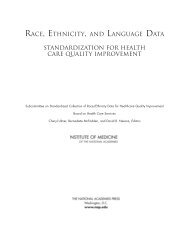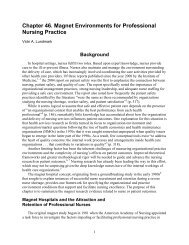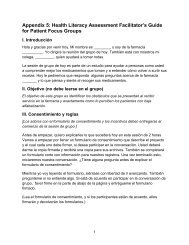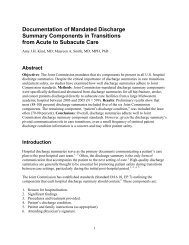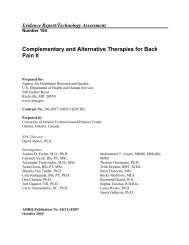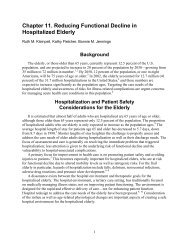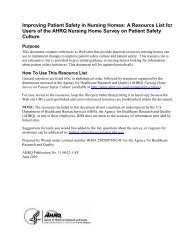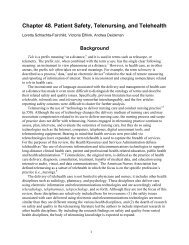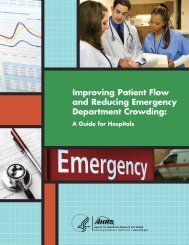Eliminating CLABSI: A National Patient Safety Imperative
Eliminating CLABSI: A National Patient Safety Imperative
Eliminating CLABSI: A National Patient Safety Imperative
Create successful ePaper yourself
Turn your PDF publications into a flip-book with our unique Google optimized e-Paper software.
<strong>Eliminating</strong> <strong>CLABSI</strong><br />
A <strong>National</strong> <strong>Patient</strong><br />
<strong>Safety</strong> <strong>Imperative</strong><br />
A Progress Report on the <strong>National</strong><br />
On the CUSP: Stop BSI Project<br />
A Project of:<br />
Health Research & Educational Trust<br />
Johns Hopkins University Quality and <strong>Safety</strong> Research Group<br />
Michigan Health & Hospital Association Keystone Center for <strong>Patient</strong> <strong>Safety</strong> & Quality<br />
Disclaimer: This report was developed with data collected and analyzed under contract<br />
with the Agency for Healthcare Research and Quality (AHRQ). The information and<br />
opinions expressed herein reflect solely the position of the authors. Nothing herein<br />
should be construed to indicate AHRQ support or endorsement of its contents.<br />
AHRQ Publication No: 11-0037-EF<br />
April 2011
CONTENTS<br />
EXECUTIVE SUMMARY .................................................................................................................................. 3<br />
Background ............................................................................................................................................... 3<br />
Progress Update ........................................................................................................................................ 3<br />
Project Impact ........................................................................................................................................... 3<br />
Conclusions ............................................................................................................................................... 3<br />
INTRODUCTION AND OBJECTIVE .................................................................................................................. 4<br />
METHODS ...................................................................................................................................................... 5<br />
Data Source ............................................................................................................................................... 5<br />
Participation Measures ............................................................................................................................. 6<br />
<strong>CLABSI</strong> Rates ............................................................................................................................................. 6<br />
RESULTS ........................................................................................................................................................ 7<br />
Project Participation ................................................................................................................................. 7<br />
Project Impact ......................................................................................................................................... 12<br />
AREAS FOR CONTINUED IMPROVEMENT ................................................................................................... 15<br />
CONCLUSION ............................................................................................................................................... 16<br />
APPENDIX A: PARTICIPATING HOSPITALS, BY STATE .................................................................................. 17<br />
TABLES<br />
Table 1: Hospital and Team Participation by State ....................................................................................... 8<br />
Table 2: Average <strong>CLABSI</strong> Rates .................................................................................................................... 13<br />
Table 3: Average <strong>CLABSI</strong> Rates .................................................................................................................... 14<br />
FIGURES<br />
Figure 1: Participation by State ..................................................................................................................... 7<br />
Figure 2: Percentage of Participating Hospitals by Bed Size ....................................................................... 10<br />
Figure 3: Percentage of Participating Hospitals by Type ............................................................................ 11<br />
Figure 4: Percentage of Participation by Unit Type .................................................................................... 12<br />
Figure 5: <strong>CLABSI</strong> Rates Over Time ............................................................................................................... 14<br />
2 <strong>Eliminating</strong> <strong>CLABSI</strong>, A <strong>National</strong> <strong>Patient</strong> <strong>Safety</strong> <strong>Imperative</strong>: <strong>National</strong> On the CUSP: Stop BSI Project Report
EXECUTIVE SUMMARY<br />
Background<br />
Healthcare-associated infections (HAIs) are infections that people acquire while they are<br />
receiving treatment for another condition in a health care setting. They are costly, deadly, and<br />
largely preventable. The U.S. Department of Health and Human Services’ Action Plan to Prevent<br />
Healthcare-Associated Infections is focusing attention on the need to dramatically reduce these<br />
infections; a recent CDC Report suggests that considerable progress is being made towards this<br />
goal. As part of this initiative, the Agency for Healthcare Research and Quality (AHRQ) is<br />
funding a national effort to prevent central line-associated bloodstream infections (<strong>CLABSI</strong>s) in<br />
U.S. hospitals. The On the CUSP: Stop BSI project is led by a unique partnership. This<br />
partnership consists of the Health Research & Educational Trust, the nonprofit research and<br />
educational affiliate of the American Hospital Association; the Johns Hopkins University Quality<br />
and <strong>Safety</strong> Research Group, which developed an innovative approach for improving patient<br />
safety; and the Michigan Health & Hospital Association’s Keystone Center for <strong>Patient</strong> <strong>Safety</strong> &<br />
Quality, which used this approach to dramatically reduce <strong>CLABSI</strong>s in Michigan. This report<br />
summarizes progress made in the first 2 years of the On the CUSP: Stop BSI project.<br />
Progress Update<br />
On the CUSP: Stop BSI requires that participating States have a lead organization that works with<br />
hospitals across their State to implement the clinical and cultural changes needed to reduce<br />
<strong>CLABSI</strong>s. Thus far, 45 State hospital associations and one other umbrella group have committed<br />
to leading the project in their States. Collectively, these groups have recruited more than 700<br />
hospitals and 1,100 hospital teams to participate in the project. Twenty-two States began the<br />
project in 2009, 14 States and the District of Columbia began during 2010, and at least 8 States<br />
plus Puerto Rico will begin the effort in early 2011.<br />
Project Impact<br />
We examined the impact of the project on patients from the adult ICUs that began participating<br />
in the project during 2009. We focused on ICUs because data from these areas are the most<br />
valid. Compared to a baseline <strong>CLABSI</strong> rate of 1.8 infections per 1,000 central line days in these<br />
units, after 12–15 months of participation in the project, <strong>CLABSI</strong> rates have decreased to 1.17<br />
infections per 1,000 central line days, a relative reduction of 35 percent. Progress for more<br />
recent participants is also being carefully evaluated.<br />
Conclusions<br />
Preliminary progress toward achieving the project’s stated goals is encouraging, but substantial<br />
work remains. Key conclusions thus far include:<br />
• Adult ICUs included in this report, drawn from 22 States and more than 350 hospitals,<br />
have reduced their <strong>CLABSI</strong> rates by an average of 35 percent.<br />
• At baseline, many of these ICUs had <strong>CLABSI</strong> rates below the national mean and were still<br />
able to reduce their rates.<br />
3 <strong>Eliminating</strong> <strong>CLABSI</strong>, A <strong>National</strong> <strong>Patient</strong> <strong>Safety</strong> <strong>Imperative</strong>: <strong>National</strong> On the CUSP: Stop BSI Project Report
• While 20 percent of hospitals in the United States are participating in the project, many<br />
more hospitals and hospital units that insert or maintain central lines would benefit from<br />
involvement in the project.<br />
• The project demonstrates that even among hospitals that have already achieved low<br />
<strong>CLABSI</strong> rates, further improvement is possible and achievable.<br />
INTRODUCTION AND OBJECTIVE<br />
Healthcare-associated infections (HAIs) are largely preventable, and their occurrence can be<br />
dramatically reduced, to save lives and excess costs. The Department of Health and Human<br />
Services (HHS) launched an Action Plan to Prevent Healthcare-Associated Infections to improve<br />
patient safety and health care quality by providing a roadmap for preventing HAIs. A recent CDC<br />
report suggests that considerable progress is being made in preventing central line associated<br />
blood stream infections, but that further improvement is still needed. 1 To further the effort to<br />
prevent HAIs, two large-scale initiatives have been funded and launched by the Agency for<br />
Healthcare Research and Quality (AHRQ). The goal of these initiatives is to prevent both central<br />
line-associated bloodstream infections (<strong>CLABSI</strong>) and catheter-associated urinary tract infections<br />
(CAUTI). Both initiatives use a combination of evidence-based best practices to reduce the risk<br />
of infections and the Comprehensive Unit-Based <strong>Safety</strong> Program (CUSP) to improve the culture<br />
of patient safety. Researchers at the Johns Hopkins University Quality and <strong>Safety</strong> Research<br />
Group (QSRG) initially developed CUSP. CUSP was subsequently implemented in collaboration<br />
with the Michigan Health & Hospital Association’s Keystone Center for <strong>Patient</strong> <strong>Safety</strong> & Quality<br />
(MHA Keystone Center) and hospitals across Michigan. This implementation resulted in a<br />
dramatic and sustained decrease in <strong>CLABSI</strong> rates in that State. 2<br />
AHRQ has awarded contracts totaling $18 million to the Health Research & Educational Trust<br />
(HRET), the nonprofit research and educational affiliate of the American Hospital Association<br />
(AHA), to lead the national initiative to reduce <strong>CLABSI</strong> rates. HRET is partnering with the QSRG<br />
at Johns Hopkins University and the MHA Keystone Center to lead this effort. A recent<br />
expansion of HRET’s contract now provides limited resources to the State hospital associations<br />
and other organizations leading this effort at the State level. Prior to this, these organizations<br />
funded their support of this project with their own resources or funds from other sources. The<br />
national On the CUSP: Stop BSI project represents the first federally funded national effort with a<br />
clearly stated outcome goal: the reduction of <strong>CLABSI</strong> rates to less than 1 per 1,000 central line<br />
1 Vital Signs: Central Line-Associated Blood Stream Infections—United States, 2001, 2008, and 2009. Morbidity and<br />
Mortality Weekly Report. Atlanta, GA: Centers for Disease Control and Prevention; 2011 Mar 1;60. Available at:<br />
http://www.cdc.gov/mmwr/pdf/wk/mm60e0301.pdf.<br />
2<br />
Pronovost P, Needham D, Berenholtz S, et al. An intervention to decrease catheter-related bloodstream infections in<br />
the ICU. N Engl J Med 2006 Dec 28;355(26):2725–2732.<br />
4 <strong>Eliminating</strong> <strong>CLABSI</strong>, A <strong>National</strong> <strong>Patient</strong> <strong>Safety</strong> <strong>Imperative</strong>: <strong>National</strong> On the CUSP: Stop BSI Project Report
days across all U.S. hospitals participating in the project. If this goal is achieved, the project will<br />
substantially reduce deaths and unnecessary costs associated with <strong>CLABSI</strong>s.<br />
Since the project’s inception in October 2008, lead organizations (primarily State hospital<br />
associations) have been recruited in 44 States. As of November 2010, 38 of these States have<br />
commenced participation in the On the CUSP: Stop BSI initiative; 22 of those States have<br />
hospitals that have been participating in the project and submitting data for over one year.<br />
Given the significance of AHRQ’s investment in this project and the role that it plays in achieving<br />
HHS’s HAI reduction goals, there is value in assessing the project to this point, with three<br />
specific goals in mind. A first goal is to examine progress made in recruiting U.S. hospitals to<br />
participate in the project. A second goal is to evaluate the impact of the project on <strong>CLABSI</strong> rates<br />
in these participating hospitals. Finally, this report seeks to identify areas where improvement<br />
must continue to occur for the project to achieve its stated goals.<br />
METHODS<br />
Data Source<br />
This report uses data stored in the On the CUSP: Stop BSI <strong>National</strong> Database created and<br />
maintained by the MHA Keystone Center in Lansing, Michigan. Each month, the number of<br />
central line days and the number of <strong>CLABSI</strong>s observed in the participating hospital units are<br />
submitted into the national database. Some hospitals submit infection rate data directly into<br />
this database, and others contribute data through the Centers for Disease Control and<br />
Prevention’s (CDC) <strong>National</strong> Healthcare <strong>Safety</strong> Network (NHSN). All hospitals use CDC<br />
definitions to count central line days and determine the number of <strong>CLABSI</strong>s observed in<br />
participating units.<br />
All analyses except the list of participating hospitals in Appendix A are based on data drawn<br />
from the <strong>National</strong> Database on October 7, 2010. Data from participating hospitals in Tennessee<br />
were added to the <strong>National</strong> Database in November 2010, so results from these hospitals will be<br />
included in the next project update. Because we want to recognize as many of the hospitals that<br />
have chosen to participate as possible, the hospital list in Appendix A reflects all participants<br />
confirmed as of January 2011.<br />
For our assessments of project impact, data were limited to teams representing adult ICUs that<br />
began participating in the project in 2009. These teams were drawn from eight States that<br />
began the project in May 2009 (cohort 1) and an additional 14 States that began the project in<br />
September 2009 (cohort 2). We limited our results to adult ICUs because of challenges in<br />
counting central line days outside the ICU setting. As such, <strong>CLABSI</strong> data for ICUs are more valid<br />
than <strong>CLABSI</strong> rates outside the ICU. Results are currently limited to the first two cohorts because<br />
5 <strong>Eliminating</strong> <strong>CLABSI</strong>, A <strong>National</strong> <strong>Patient</strong> <strong>Safety</strong> <strong>Imperative</strong>: <strong>National</strong> On the CUSP: Stop BSI Project Report
they have at least four quarters of data that can be used to assess <strong>CLABSI</strong> rate changes over<br />
time.<br />
Participation Measures<br />
Data from the On the CUSP: Stop BSI <strong>National</strong> Database were linked to information in the 2008<br />
AHA Annual Survey of hospitals based on hospital name, location, and AHA hospital identifier<br />
(when available and accurate). All hospitals that could be linked were classified by size using the<br />
“total beds staffed” variable from the AHA Annual Survey. Hospitals were also classified based<br />
on whether they were critical access hospitals, rural referral hospitals, members of a health care<br />
system, located in one of the 100 largest cities in the United States, or members of the Council<br />
of Teaching Hospitals (COTH). Because hospitals in North Carolina and Ohio use blinded<br />
hospital identifiers, hospital characteristics were not available for those hospitals or for an<br />
additional nine hospitals that could not be matched to data in the AHA Annual Survey.<br />
<strong>CLABSI</strong> Rates<br />
<strong>CLABSI</strong> rates for the two cohorts were calculated for a baseline time period of up to 12 months<br />
and for each subsequent time period. At the time of the production of this report each cohort<br />
had at least four full quarters of data. The time periods are shown below:<br />
Time Period<br />
(Non-Calendar Quarters)<br />
Cohort 1 Cohort 2<br />
Baseline May 1, 2008 to Apr. 30,<br />
2009<br />
Sept. 1, 2008 to Aug. 31, 2009<br />
Time period 1 May 1, 2009 to July 31,<br />
2009<br />
Sept. 1, 2009 to Nov. 30, 2009<br />
Time period 2 Aug. 1, 2009 to Oct. 31,<br />
2009<br />
Dec. 1, 2009 to Feb. 28, 2010<br />
Time period 3 Nov. 1, 2009 to Jan. 31,<br />
2010<br />
Mar. 1, 2010 to May 31, 2010<br />
Time period 4 Feb. 1, 2010 to July 31,<br />
2010<br />
June 1, 2010 to Sept. 31, 2010<br />
Central line days were calculated as the sum of all reported central line days during the<br />
reporting period, while the number of <strong>CLABSI</strong>s equaled the sum total of all <strong>CLABSI</strong>s reported<br />
during the period. The <strong>CLABSI</strong> rate equals the ratio of <strong>CLABSI</strong>s to central line days multiplied by<br />
1,000 (to create a rate per 1,000 central line days). If a team reported zero central line days, the<br />
<strong>CLABSI</strong> rate for that period was set to “missing.” However, the team still was classified as having<br />
reported <strong>CLABSI</strong> data for that period.<br />
6 <strong>Eliminating</strong> <strong>CLABSI</strong>, A <strong>National</strong> <strong>Patient</strong> <strong>Safety</strong> <strong>Imperative</strong>: <strong>National</strong> On the CUSP: Stop BSI Project Report
RESULTS<br />
Project Participation<br />
State Participation. Recruitment to the project is an ongoing process that began in fall 2008 and<br />
is continuing. Lead organizations in States were encouraged to recruit as many teams of<br />
participants as they could. The ongoing success of this program, awareness of impending CMS<br />
public reporting of <strong>CLABSI</strong> rates, and the 2011 requirement that hospitals submit <strong>CLABSI</strong> data<br />
into NHSN are encouraging additional hospitals to enroll. Once States agreed to participate,<br />
they were placed into a project group or “cohort” along with other States beginning the project<br />
at the same time. At present, five cohorts of States are participating in the project, and a sixth is<br />
scheduled to begin in January 2011. Many States are continuing to recruit additional hospital<br />
teams to participate. As a result, some lead organizations are supporting hospital participants in<br />
one or more of the project cohorts. Figure 1 illustrates the current status of State recruitment<br />
efforts.<br />
Figure 1: Participation by State<br />
7 <strong>Eliminating</strong> <strong>CLABSI</strong>, A <strong>National</strong> <strong>Patient</strong> <strong>Safety</strong> <strong>Imperative</strong>: <strong>National</strong> On the CUSP: Stop BSI Project Report
Forty-four States plus the District of Columbia and Puerto Rico have committed to participating<br />
in one of the six cohorts. Although Michigan is not listed as a formal project participant,<br />
Michigan hospitals continue to work with the MHA Keystone Center on sustaining the<br />
exceptionally low <strong>CLABSI</strong> rates they achieved in the initial Keystone Project. 3,4 The State of<br />
Washington has participated in some project activities but has not submitted any <strong>CLABSI</strong> data.<br />
Levels of participation within States vary substantially. Table 1 provides a breakdown of the<br />
number of participating hospitals and teams by State. This table is limited to the first four<br />
project cohorts; cohorts 5 and 6 are still actively recruiting hospital participants. Because some<br />
States have a higher percentage of very small hospitals that do not have an ICU or insert central<br />
lines, some variation in the percentage of hospitals in each State that could benefit from project<br />
participation is to be expected. Alabama, Delaware, Hawaii, and Maryland all have more than 50<br />
percent of their hospitals participating in the project.<br />
State<br />
Table 1: Hospital and Team Participation by State<br />
Information detailed reflective of data entered as of<br />
October 7, 2010<br />
Participating<br />
Teams 5<br />
Participating<br />
Hospitals<br />
Community<br />
Hospitals in<br />
State 6<br />
Hospital<br />
Recruitment<br />
Percentage<br />
Hospitals in<br />
State with an<br />
ICU 7<br />
AL 91 77 115 67% 68<br />
AR 54 28 95 29% 49<br />
CO 8 6 84 7% 42<br />
CT 18 15 35 43% 25<br />
DE 14 8 7 114% 6<br />
FL 73 35 215 16% 111<br />
GA 36 23 154 15% 79<br />
HI 38 16 25 64% 14<br />
IA 17 9 118 8% 75<br />
IL 71 35 189 19% 127<br />
IN 20 15 134 11% 86<br />
3<br />
Pronovost P, Needham D, Berenholtz S, et al. An intervention to decrease catheter-related bloodstream infections in<br />
the ICU. N Engl J Med 2006 Dec 28;355(26):2725–2732.<br />
4<br />
Pronovost PJ, Goeschel CA, Colantuoni E, et al. Sustaining reductions in catheter-related bloodstream infections in<br />
Michigan intensive care units: an observational study. BMJ 2010 Feb 4;340:c309.<br />
5<br />
Teams normally represent a single unit, but some teams include personnel from multiple units.<br />
6<br />
The term “Community Hospitals in State” reflects those hospitals defined as “Community Hospitals” in the AHA<br />
Annual Survey and refers to all nonfederal, short-term and long-term general acute care hospitals. The recruitment<br />
percentage is calculated based on this number. There are instances where participating hospitals are not<br />
characterized as community hospitals, and these result in a recruitment percentage greater than 100.<br />
7<br />
This category denotes hospitals with some form of an ICU. The project is reporting this because this hospital<br />
designation accounts for the majority of project participants, as well as the majority of hospitals likely to insert central<br />
lines and to experience <strong>CLABSI</strong>s.<br />
8 <strong>Eliminating</strong> <strong>CLABSI</strong>, A <strong>National</strong> <strong>Patient</strong> <strong>Safety</strong> <strong>Imperative</strong>: <strong>National</strong> On the CUSP: Stop BSI Project Report
KS 12 9 146 6% 55<br />
KY 59 33 109 30% 58<br />
MA 18 12 80 15% 51<br />
MD 58 37 49 76% 43<br />
MN 28 10 133 8% 67<br />
MO 10 10 134 7% 87<br />
NC 47 29 117 25% 82<br />
NE 17 8 90 9% 25<br />
NH 10 9 28 32% 25<br />
NJ 53 37 80 46% 56<br />
NV 17 8 43 19% 16<br />
NY 29 22 191 12% 123<br />
OH 64 57 195 29% 132<br />
OK 17 13 135 10% 46<br />
OR 4 4 59 7% 52<br />
PA 45 26 197 13% 125<br />
SC 47 22 72 31% 54<br />
TX 43 26 520 5% 268<br />
VA 38 23 91 25% 56<br />
WI 79 40 132 30% 84<br />
WV 29 20 58 34% 37<br />
Hospital Participation. Because <strong>CLABSI</strong>s can occur in all sizes and types of hospitals in which<br />
central lines are used, this project has encouraged each State lead organization to enlist the<br />
participation of all hospitals that use central lines when recruiting. Figure 2 summarizes the<br />
participation of hospitals in this project based on their size (defined by the number of hospital<br />
beds). Percentages were based on the number of hospitals with an adult ICU of each size<br />
participating in the project divided by the total number of hospitals of each size with an adult<br />
medical or surgical ICU (based on data in the 2008 AHA Annual Survey).<br />
9 <strong>Eliminating</strong> <strong>CLABSI</strong>, A <strong>National</strong> <strong>Patient</strong> <strong>Safety</strong> <strong>Imperative</strong>: <strong>National</strong> On the CUSP: Stop BSI Project Report
Figure 2: Percentage of Participating Hospitals by Bed Size<br />
Thus far, project recruitment has been strongest among hospitals with more than 400 beds, and<br />
weakest among hospitals with fewer than 100 beds. Although small hospitals insert central lines<br />
in their ICUs, the number of insertions is often very low, which perhaps has made <strong>CLABSI</strong><br />
prevention a lower priority for these hospitals.<br />
Figure 3 summarizes the recruitment levels for hospitals with a range of characteristics. More<br />
than 24 percent of teaching hospitals with ICUs are participating in the project. The involvement<br />
of rural referral hospitals, hospitals from the 100 largest cities, and hospitals that are part of<br />
hospital systems is slightly lower. Efforts to bolster recruitment in groups where involvement is<br />
lower are ongoing.<br />
10 <strong>Eliminating</strong> <strong>CLABSI</strong>, A <strong>National</strong> <strong>Patient</strong> <strong>Safety</strong> <strong>Imperative</strong>: <strong>National</strong> On the CUSP: Stop BSI Project Report
Figure 3: Percentage of Participating Hospitals by Type<br />
Appendix A provides a full list of all hospitals participating in the project as of January 2011.<br />
Ohio and Washington have not provided the names of participating hospitals, so those are not<br />
included. Because the number of participating hospitals continues to grow, the list of<br />
participating hospitals maintained on the project Web site at www.onthecuspstophai.org<br />
provides the best source of current information on which hospitals have chosen to participate.<br />
While the list in Appendix A and on the Web site includes every hospital that has been enrolled<br />
in the national project database, some hospitals on this list may not be continuing to submit<br />
<strong>CLABSI</strong> data or participate in scheduled project activities on a regular basis.<br />
Unit Team Participation. Because the vast majority of central lines are placed in patients in an<br />
ICU, recruiting ICU teams has been the project’s primary focus. However, some central lines are<br />
placed and maintained in non-ICU units. Thus, teams representing these units are also<br />
participating. At present, some pediatric or neonatal ICUs are participating in the project; HRET<br />
is working with other organizations that specialize in pediatric care to provide focused guidance<br />
to hospitals seeking to prevent <strong>CLABSI</strong>s in pediatric and neonatal ICUs. Figure 4 illustrates the<br />
range of units participating in the first four cohorts of the On the CUSP: Stop BSI initiative.<br />
11 <strong>Eliminating</strong> <strong>CLABSI</strong>, A <strong>National</strong> <strong>Patient</strong> <strong>Safety</strong> <strong>Imperative</strong>: <strong>National</strong> On the CUSP: Stop BSI Project Report
Figure 4: Percentage of Participation by Unit Type<br />
More than 75 percent of units participating in the project thus far are ICUs, with a substantial<br />
majority of the ICUs consisting of adult medical/surgical ICUs.<br />
Project Impact<br />
While participation of hospitals is critical, the ultimate measure of success is the reduction of<br />
<strong>CLABSI</strong> rates. 8 Table 2 summarizes <strong>CLABSI</strong> rates at baseline and in each of the four measurement<br />
periods following the inception of the project.<br />
8 A second stated project goal is the improvement in safety culture in participating units. Significant and sustained<br />
improvement in a clinical outcome such as <strong>CLABSI</strong> requires a culture where all staff understand and can be held<br />
accountable for ensuring the safety of patients. To assess progress in culture change, participating units are asked to<br />
complete the AHRQ <strong>Safety</strong> Culture survey at the start and end of the project. Results of these administrations of the<br />
survey will be reported when they become available.<br />
12 <strong>Eliminating</strong> <strong>CLABSI</strong>, A <strong>National</strong> <strong>Patient</strong> <strong>Safety</strong> <strong>Imperative</strong>: <strong>National</strong> On the CUSP: Stop BSI Project Report
Table 2: Average <strong>CLABSI</strong> Rates<br />
Cohorts 1 & 2 with units reporting during ANY of the five time periods<br />
Information detailed reflective of data entered as of October 7, 2010.<br />
Baseline Period 1 Period 2 Period 3 Period 4<br />
12 months<br />
prior to<br />
intervention<br />
Months 1-3<br />
post<br />
intervention<br />
Months 4-6<br />
post<br />
intervention<br />
Months 7-9<br />
post<br />
intervention<br />
Months 10-15<br />
post<br />
intervention<br />
Number of States 20 20 20 20 20<br />
Number of units<br />
reporting 384 436 435 434 402<br />
Average <strong>CLABSI</strong>s/unit 3.12 0.93 0.72 0.65 0.64<br />
Average CL days/unit 1680 510 508 507 556<br />
Average BSI rate 1.80 1.64 1.31 1.14 1.17<br />
95% confidence interval ( 1.53, 2.08) ( 1.39, 1.89) ( 1.09, 1.53) ( 0.94, 1.35) ( 0.89, 1.44)<br />
Change from baseline* NA -0.19 -0.53 -0.61 -0.59<br />
(-0.58, (-0.89,-<br />
95% confidence interval<br />
0.20) 0.17) (-0.97,-0.25) (-1.01,-0.17)<br />
* Based on unpaired comparison of unit rates between time periods<br />
For all adult ICUs participating in the first two project cohorts, rates have dropped from an<br />
average of 1.8 infections per 1,000 central line days to 1.17 infections per 1,000 central line days,<br />
an overall relative reduction of 35 percent. Because mean <strong>CLABSI</strong> rates can be distorted by one<br />
or more units with very high rates, it is useful to examine both mean and median <strong>CLABSI</strong> rates.<br />
Figure 5 illustrates the changes in mean and median <strong>CLABSI</strong> rates across the data reporting<br />
periods. More than half of all participating units reported zero <strong>CLABSI</strong>s in each reporting period<br />
since they began participating in the project. Working to assist units that have not achieved this<br />
rate remains a top project priority.<br />
13 <strong>Eliminating</strong> <strong>CLABSI</strong>, A <strong>National</strong> <strong>Patient</strong> <strong>Safety</strong> <strong>Imperative</strong>: <strong>National</strong> On the CUSP: Stop BSI Project Report
Figure 5: <strong>CLABSI</strong> Rates Over Time<br />
Infections per 1,000 Central Line Days<br />
Table 2 and Figure 5 include data from all units that reported data in each of the measurement<br />
periods. It is possible that the worst performing units at baseline simply failed to report data<br />
during later time periods, leading to an artificial drop in the rates. To rule out this possibility,<br />
the same analysis was performed using only units that reported data at baseline and in each<br />
subsequent reporting period. Table 3 presents these results, which are very similar.<br />
Table 3: Average <strong>CLABSI</strong> Rates<br />
Cohorts 1 & 2 with units reporting during ALL of the five time periods<br />
Information detailed reflective of data entered as of October 7, 2010.<br />
Baseline Period 1 Period 2 Period 3 Period 4<br />
12 months<br />
prior to<br />
intervention<br />
Months 1-3<br />
post<br />
intervention<br />
Months 4-6<br />
post<br />
intervention<br />
Months 7-9<br />
post<br />
intervention<br />
Months 10-<br />
15 post<br />
intervention<br />
Number of States 20 20 20 20 20<br />
Number of units reporting 349 349 349 349 349<br />
Average <strong>CLABSI</strong>s/unit 3.20 0.83 0.69 0.67 0.66<br />
Average CL days/unit 1736 499 502 518 598<br />
Average BSI rate 1.76 1.65 1.31 1.22<br />
( 0.98,<br />
1.21<br />
95% confidence interval ( 1.51, 2.01) ( 1.36, 1.93) ( 1.07, 1.55) 1.45) ( 0.90, 1.52)<br />
Change from baseline* NA -0.11 -0.45 -0.54 -0.55<br />
95% confidence interval<br />
(-0.44,<br />
0.22)<br />
(-0.77,-<br />
0.13)<br />
(-0.83,-<br />
0.26)<br />
(-0.93,-<br />
0.17)<br />
14 <strong>Eliminating</strong> <strong>CLABSI</strong>, A <strong>National</strong> <strong>Patient</strong> <strong>Safety</strong> <strong>Imperative</strong>: <strong>National</strong> On the CUSP: Stop BSI Project Report
* Based on paired comparison of unit rates between time periods<br />
Overall, rates decreased in the units with complete data by 31 percent, from 1.76 to 1.21<br />
<strong>CLABSI</strong>s per 1,000 central line days, indicating that the <strong>CLABSI</strong> rate reductions observed in<br />
project participants cannot be attributed to missing data. One of the more surprising findings in<br />
this data is the relatively low baseline <strong>CLABSI</strong> rates. Alternative explanations for these low rates<br />
are being examined. However, we do not believe that only hospitals with good rates are<br />
participating in the project.<br />
The other data concern is the accuracy of self-reported <strong>CLABSI</strong> rates. Data validation is not<br />
included in the scope of the project at this point. However, data submitted directly into our<br />
national project database is subject to more screens for accuracy than is currently the case for<br />
data submitted into NHSN. The national project team is continuing to work with AHRQ and<br />
CDC to explore the issue of validation.<br />
AREAS FOR CONTINUED IMPROVEMENT<br />
Although the results described above indicate that the project is making substantial progress<br />
toward achieving its recruitment and <strong>CLABSI</strong> reduction goals, opportunities for improvement<br />
remain. The three most important areas for improvement are:<br />
• Recruitment: With fewer than 20 percent of U.S. hospitals containing an ICU<br />
participating in this project, encouraging additional hospitals to be involved in this<br />
project remains a priority. Certainly some hospitals have participated in very successful<br />
local or regional efforts to reduce <strong>CLABSI</strong>s and have compelling data demonstrating the<br />
success of their efforts. However, most nonparticipating hospitals have not made the<br />
changes needed to produce sustainable <strong>CLABSI</strong> rates near zero. The leadership of the<br />
American Hospital Association and many State hospital associations are working with<br />
AHRQ, CDC, and the On the CUSP: Stop BSI national project team to encourage all<br />
hospitals to participate in the project.<br />
• Data submission: As reflected in tables 2 and 3, only 80 percent of participating adult<br />
ICUs in the first two cohorts have submitted <strong>CLABSI</strong> rate data in each of the reporting<br />
periods. While data submission does not improve <strong>CLABSI</strong> rates, a failure to continuously<br />
monitor <strong>CLABSI</strong>s and to use each infection to identify processes that must be improved<br />
to prevent them in the future will not lead to sustained improvement. The national<br />
leadership of the project is working closely with the lead organizations in every<br />
participating State to encourage all participating hospitals to remain fully engaged in the<br />
project for its duration and in the monitoring and reporting of their <strong>CLABSI</strong> rates.<br />
15 <strong>Eliminating</strong> <strong>CLABSI</strong>, A <strong>National</strong> <strong>Patient</strong> <strong>Safety</strong> <strong>Imperative</strong>: <strong>National</strong> On the CUSP: Stop BSI Project Report
• Variability: Although <strong>CLABSI</strong> rates have dropped significantly in the first two cohorts,<br />
substantial variability remains between participating units in these cohorts. For the<br />
project to reach its stated goal, more than half the units participating in the project must<br />
have zero <strong>CLABSI</strong>s in any given quarter. At present, this standard has not been achieved,<br />
so working to reduce variability between units and States and across measurement<br />
periods remains a high priority.<br />
CONCLUSION<br />
Results reported above are aligned with a very encouraging CDC report on the decline in the<br />
number of <strong>CLABSI</strong>s between 2001 and 2009. That report found a decrease in the ICU <strong>CLABSI</strong><br />
rate from 3.64 per thousand line days in 2001 to 1.65 per thousand line days in 2009. 9 While<br />
differences in the methods used to calculate these rates mean that comparisons should be<br />
made quite cautiously, it does appear that the On the CUSP: Stop BSI project is both succeeding<br />
in recruiting units that have higher <strong>CLABSI</strong> rates than the national average and in helping these<br />
units decrease their rates well below the national average that CDC reports.<br />
This report is not a comprehensive analysis of every important question related to the On the<br />
CUSP: Stop BSI national initiative. The national project team continues to conduct analyses to<br />
better understand which units are succeeding, which are struggling and why, so that changes<br />
may be made to the initiative to maximize its impact for every participating hospitals. Better<br />
understanding the root causes of <strong>CLABSI</strong>s that continue to occur sporadically in even highperforming<br />
units may also lead to important insights. Continuing to help hospitals correctly<br />
count central line days and identify <strong>CLABSI</strong>s is vital to efforts to prevent them and to increase<br />
public confidence that this risk to patient safety is being reduced or even eliminated. While<br />
much of the work on this national initiative still remains, the results in this report indicate that<br />
significant progress is being made toward achieving its goals.<br />
9 Vital Signs: Central Line-Associated Blood Stream Infections—United States, 2001, 2008, and 2009. Morbidity and<br />
Mortality Weekly Report. Atlanta, GA: Centers for Disease Control and Prevention; 2011 Mar 1;60. Available at:<br />
http://www.cdc.gov/mmwr/pdf/wk/mm60e0301.pdf.<br />
16 <strong>Eliminating</strong> <strong>CLABSI</strong>, A <strong>National</strong> <strong>Patient</strong> <strong>Safety</strong> <strong>Imperative</strong>: <strong>National</strong> On the CUSP: Stop BSI Project Report
APPENDIX A: PARTICIPATING HOSPITALS, BY STATE<br />
Alabama<br />
Andalusia Regional Hospital, Andalusia<br />
Athens-Limestone Hospital, Athens<br />
Atmore Community Hospital, Atmore<br />
Baptist Medical Center East, Montgomery<br />
Baptist Medical Center South, Montgomery<br />
Bibb Medical Center, Centreville<br />
Brookwood Medical Center, Birmingham<br />
Cherokee Medical Center, Centre<br />
Chilton Medical Center, Clanton<br />
Clay County Hospital, Ashland<br />
Community Hospital, Tallassee<br />
Cooper Green Mercy Hospital, Birmingham<br />
Coosa Valley Medical Center, Sylacauga<br />
Crestwood Medical Center, Huntsville<br />
Cullman Regional Medical Center, Cullman<br />
D.W. McMillan Memorial Hospital, Brewton<br />
Dale Medical Center, Ozark<br />
DCH Regional Medical Center, Tuscaloosa<br />
Decatur General Hospital, Decatur<br />
DeKalb Regional Medical Center, Fort Payne<br />
East Alabama Medical Center, Opelika<br />
Elba General Hospital, Elba<br />
Eliza Coffee Memorial Hospital, Florence<br />
Evergreen Medical Center, Evergreen<br />
Fayette Medical Center, Fayette<br />
Flowers Hospital, Dothan<br />
Florala Memorial Hospital, Florala<br />
Gadsden Regional Medical Center, Gadsden<br />
Georgiana Hospital, Georgiana<br />
Grove Hill Memorial Hospital, Grove Hill<br />
Hale County Hospital, Greensboro<br />
Helen Keller Hospital, Sheffield<br />
Highlands Medical Center, Scottsboro<br />
Huntsville Hospital, Huntsville<br />
Infirmary West, Mobile<br />
J. Paul Jones Hospital, Camden<br />
Jackson Hospital, Montgomery<br />
Jackson Medical Center, Jackson<br />
Jacksonville Medical Center, Jacksonville<br />
L.V. Stabler Memorial Hospital, Greenville<br />
Lanier Health Services, Valley<br />
Marion Regional Medical Center, Hamilton<br />
Marshall Medical Center North, Guntersville<br />
Marshall Medical Center South, Boaz<br />
Medical Center Barbour, Eufaula<br />
Medical Center Enterprise, Enterprise<br />
Medical West, an affiliate of University of<br />
Alabama-Birmingham Health System,<br />
Bessemer<br />
Mizell Memorial Hospital, Opp<br />
Mobile Infirmary Medical Center, Mobile<br />
Monroe County Hospital, Monroeville<br />
North Baldwin Infirmary, Bay Minette<br />
Northeast Alabama Regional Medical<br />
Center, Anniston<br />
Northport Medical Center, Northport<br />
Parkway Medical Center, Decatur<br />
Pickens County Medical Center, Carrollton<br />
Prattville Baptist Hospital, Prattville<br />
Princeton Baptist Medical Center,<br />
Birmingham<br />
Providence Hospital, Mobile<br />
Randolph Medical Center, Roanoke<br />
Red Bay Hospital, Red Bay<br />
Riverview Regional Medical Center, Gadsden<br />
Russell Medical Center, Alexander City<br />
Russellville Hospital, Russellville<br />
Shelby Baptist Medical Center, Alabaster<br />
Shoals Hospital, Muscle Shoals<br />
South Baldwin Regional Medical Center,<br />
Foley<br />
Southeast Alabama Medical Center, Dothan<br />
Springhill Medical Center, Mobile<br />
St. Vincent's Birmingham, Birmingham<br />
St. Vincent's Blount, Oneonta<br />
St. Vincent's East, Birmingham<br />
St. Vincent's St. Clair, Pell City<br />
Thomas Hospital, Fairhope<br />
Trinity Medical Center, Birmingham<br />
Troy Regional Medical Center, Troy<br />
17 <strong>Eliminating</strong> <strong>CLABSI</strong>, A <strong>National</strong> <strong>Patient</strong> <strong>Safety</strong> <strong>Imperative</strong>: <strong>National</strong> On the CUSP: Stop BSI Project Report
University of Alabama-Birmingham Hospital<br />
(Including UAB Highlands), Birmingham<br />
University of South Alabama (USA) Medical<br />
Center, Mobile<br />
Vaughan Regional Medical Center, Selma<br />
Wiregrass Medical Center, Geneva<br />
Arkansas<br />
Arkansas Heart Hospital, Little Rock<br />
Baptist Health Extended Care Hospital, Little<br />
Rock<br />
Baptist Health Medical Center, Arkadelphia<br />
Baptist Health Medical Center, Heber<br />
Springs<br />
Baptist Health Medical Center, Little Rock<br />
Baptist Health Medical Center, North Little<br />
Rock<br />
Baxter Regional Medical Center, Mountain<br />
Home<br />
Bradley County Medical Center, Warren<br />
Crittenden Regional Hospital, West<br />
Memphis<br />
CrossRidge Community Hospital, Wynne<br />
Drew Memorial Hospital, Monticello<br />
Five Rivers Medical Center, Pocahontas<br />
Lawrence Memorial Hospital, Walnut Ridge<br />
Mercy Medical Center, Rogers<br />
NEA Baptist Memorial Hospital, Jonesboro<br />
North Arkansas Regional Medical Center,<br />
Harrison<br />
Ouachita County Medical Center, Camden<br />
Ozark Health Medical Center, Clinton<br />
Saint Mary’s Regional Medical Center,<br />
Russellville<br />
St. Edward Mercy Medical Center, Fort Smith<br />
St. Joseph’s Mercy Health Center, Hot<br />
Springs<br />
University Hospital of Arkansas, Little Rock<br />
Washington Regional Medical Center,<br />
Fayetteville<br />
White County Medical Center, Searcy<br />
White River Medical Center, Batesville<br />
Colorado<br />
Exempla Lutheran Medical Center, Wheat<br />
Ridge<br />
Exempla Saint Joseph Hospital, Denver<br />
Poudre Valley Hospital, Fort Collins<br />
Southwest Memorial Hospital, Southwest<br />
St. Mary-Corwin Medical Center, Pueblo<br />
University Hospital, Denver<br />
Connecticut<br />
Bridgeport Hospital, Bridgeport<br />
Bristol Hospital, Bristol<br />
Danbury Hospital, Danbury<br />
Hospital of Saint Raphael, New Haven<br />
John Dempsey Hospital, University of<br />
Connecticut Health Center, Farmington<br />
Lawrence and Memorial Hospital, New<br />
London<br />
Manchester Memorial Hospital, Manchester<br />
Norwalk Hospital, Norwalk<br />
Rockville General Hospital, Vernon<br />
Saint Francis Hospital and Medical Center,<br />
Hartford<br />
Saint Mary's Hospital, Waterbury<br />
St. Vincent’s Medical Center, Bridgeport<br />
Waterbury Hospital, Waterbury<br />
The William W. Backus Hospital, Norwich<br />
Yale-New Haven Hospital, New Haven<br />
Delaware<br />
Alfred I duPont Hospital for Children,<br />
Wilmington<br />
Beebe Medical Center, Lewes<br />
Christiana Hospital, Newark<br />
Kent General Hospital, Dover<br />
Milford Memorial Hospital, Milford<br />
Nanticoke Memorial Hospital, Seaford<br />
St. Francis Hospital, Wilmington<br />
Wilmington Hospital, Wilmington<br />
District of Columbia<br />
Washington Hospital Center, Washington<br />
DC<br />
18 <strong>Eliminating</strong> <strong>CLABSI</strong>, A <strong>National</strong> <strong>Patient</strong> <strong>Safety</strong> <strong>Imperative</strong>: <strong>National</strong> On the CUSP: Stop BSI Project Report
<strong>National</strong> Rehabilitation Hospital,<br />
Washington DC<br />
Georgetown University Hospital,<br />
Washington DC<br />
George Washington University Hospital,<br />
Washington DC<br />
Sibley Memorial Hospital, Washington DC<br />
Howard University Hospital, Washington DC<br />
Florida<br />
Adventist Health System, Winter Park<br />
Baptist Hospital, Pensacola<br />
Baptist Hospital of Miami, Miami<br />
Baptist Medical Center South, Jacksonville<br />
Cape Canaveral Hospital, Cocoa Beach<br />
Cape Coral Hospital, Cape Coral<br />
Citrus Memorial Health System, Inverness<br />
Doctors Hospital, Coral Gables<br />
Gulf Coast Medical Center, Fort Myers<br />
H. Lee Moffitt Cancer Center, Tampa<br />
Health Central, Ocoee<br />
HealthPark Medical Center, Fort Myers<br />
Holmes Regional Medical Center,<br />
Melbourne<br />
Holy Cross Hospital, Fort Lauderdale<br />
Homestead Hospital, Homestead<br />
Jupiter Medical Center, Jupiter<br />
Lakeland Regional Medical Center, Lakeland<br />
Lee Memorial Hospital, Fort Myers<br />
Mariners Hospital, Tavernier<br />
Mayo Clinic Hospital, Florida, Jacksonville<br />
Memorial Hospital Miramar, Miramar<br />
Memorial Hospital Pembroke, Pembroke<br />
Pines<br />
Memorial Hospital West, Pembroke Pines<br />
Memorial Regional Hospital, Hollywood<br />
Memorial Regional Hospital South,<br />
Hollywood<br />
Munroe Regional Medical Center, Ocala<br />
NCH Healthcare System, Naples<br />
North Broward Medical Center, Deerfield<br />
Beach<br />
Orlando Regional Medical Center, Orlando<br />
Palm Bay Hospital, Palm Bay<br />
Sacred Heart Hospital of Pensacola,<br />
Pensacola<br />
Sarasota Memorial Health Care System,<br />
Sarasota<br />
Shands at the University of Florida,<br />
Gainesville<br />
Shands Jacksonville Medical Center,<br />
Jacksonville<br />
South Miami Hospital, South Miami<br />
Tallahassee Memorial HealthCare,<br />
Tallahassee<br />
Georgia<br />
Atlanta Medical Center, Atlanta<br />
Cartersville Medical Center, Cartersville<br />
DeKalb Medical Hillandale, Lithonia<br />
DeKalb Medical North Decatur, Decatur<br />
Emory Eastside Medical Center, Snellville<br />
Emory Johns Creek Hospital, Duluth<br />
Emory University Hospital, Atlanta<br />
Emory University Hospital Midtown, Atlanta<br />
Emory University Hospital, Wesley Woods,<br />
Atlanta<br />
Emory-Adventist Hospital, Smyrna<br />
Floyd Medical Center, Rome<br />
Gwwinett Medical Center Hospital,<br />
Lawrenceville<br />
Habersham Medical Center, Demorest<br />
Houston Healthcare Perry Hospital, Perry<br />
Hutcheson Medical Center, Fort Ogelthorpe<br />
Liberty Regional Medical Center, Hinesville<br />
Memorial Hospital and Manor, Bainbridge<br />
Newton Medical Center, Covington<br />
Phoebe Putney Memorial Hospital, Albany<br />
Piedmont Newman Hospital, Newnan<br />
Redmond Regional Medical Center, Rome<br />
St. Francis Hospital, Columbus<br />
Tift Regional Medical Center, Tifton<br />
Upson Regional Medical Center, Thomaston<br />
WellStar Cobb Hospital, Austell<br />
WellStar Kennestone Hospital, Marietta<br />
West Georgia Health System, LaGrange<br />
19 <strong>Eliminating</strong> <strong>CLABSI</strong>, A <strong>National</strong> <strong>Patient</strong> <strong>Safety</strong> <strong>Imperative</strong>: <strong>National</strong> On the CUSP: Stop BSI Project Report
Hawaii<br />
Castle Medical Center, Kailua<br />
Hawaii Medical Center East, Honolulu<br />
Hawaii Medical Center West, Ewa Beach<br />
Hilo Medical Center, Hilo<br />
Kaiser Permanente Hospital, Honolulu<br />
Kapiolani Medical Center for Women and<br />
Children, Honolulu<br />
Kona Community Hospital, Kealakekua<br />
Kuakini Medical Center, Honolulu<br />
KVMH-West Kauai Medical Center, Waimea<br />
Maui Memorial Medical Center, Wailuku<br />
North Hawaii Community Hospital, Kamuela<br />
Pali Momi Medical Center, Aiea<br />
Straub Hospital and Clinic, Honolulu<br />
The Queens Medical Center, Honolulu<br />
Tripler Army Medical Center, Honolulu<br />
Wahiawa General Hospital, Wahiawa<br />
Wilcox Memorial Hospital, Lihue<br />
Illinois<br />
Carle Foundation Hospital, Urbana<br />
Centegra, McHenry<br />
Centegra, Woodstock<br />
CGH Medical Center, Sterling<br />
Decatur Memorial Hospital, Decatur<br />
Delnor Community Hospital, Geneva<br />
Edward Hospital, Naperville<br />
Fayette County Hospital, Vandalia<br />
Ferrell Hospital, Eldorado<br />
FHN Memorial Hospital, Freeport<br />
Greenville Regional Hospital, Greenville<br />
Hamilton Memorial Hospital District,<br />
McLeansboro<br />
Harrisburg Medical Center, Harrisburg<br />
Iroquois Memorial Hospital, Watseka<br />
Jerseyville Community Hospital, Jerseyville<br />
Katherine Shaw Bethea Hospital, Dixon<br />
Kewanee Hospital, Kewanee<br />
Kindred Hospital Chicago, Northlake<br />
Kishwaukee Community Hospital, DeKalb<br />
Loretto Hospital, Chicago<br />
Loyola Gottlieb Memorial Hospital, Melrose<br />
Park<br />
MacNeal Hospital, Berwyn<br />
Mason District Hospital, Havana<br />
McDonough District Hospital, Macomb<br />
Memorial Medical Center, Springfield<br />
Mercy Hospital, Chicago<br />
MetroSouth Medical Center, Blue Island<br />
Morris Hospital and Healthcare System,<br />
Morris<br />
Mount Sinai Hospital, Chicago<br />
OSF Saint Anthony Medical Center,<br />
Rockford<br />
OSF Saint Mary Medical Center, Galesburg<br />
Ottawa Regional Hospital, Ottawa<br />
Pekin Hospital, Pekin<br />
Pickneyville Community Hospital,<br />
Pickneyville<br />
Proctor Hospital, Peoria<br />
Provena Saint Joseph Medical Center, Joliet<br />
Provena Saint Mary's Hospital, Kankakee<br />
Riverside Medical Center, Kankakee<br />
Rockford Memorial Hospital, Rockford<br />
Rush Copley Medical Center, Aurora<br />
Rush Oak Park Hospital, Oak Park<br />
Sacred Heart Hospital, Chicago<br />
St. Anthony's Health System, Alton<br />
St. Alexius Medical Center, Hoffman Estates<br />
St. Mary's and Elizabeth's Medical Center,<br />
Chicago<br />
Sparta Community Hospital, Sparta<br />
Thomas H. Boyd Memorial Hospital,<br />
Carrollton<br />
Valley West Community Hospital, Sandwich<br />
Vista Health System, Waukegan<br />
Indiana<br />
Deaconess Hospital, Evansville<br />
Munster Community, Munster<br />
Saint Margaret Mercy, Dyer<br />
Schneck Medical Center, Seymour<br />
St. Vincent Heart Center of Indiana,<br />
Indianapolis<br />
St. Francis Hospital, Beech Grove Campus,<br />
Beech Grove<br />
St. Mary Medical Center, Hobart<br />
20 <strong>Eliminating</strong> <strong>CLABSI</strong>, A <strong>National</strong> <strong>Patient</strong> <strong>Safety</strong> <strong>Imperative</strong>: <strong>National</strong> On the CUSP: Stop BSI Project Report
St. Vincent Dunn Hospital, Bedford<br />
Iowa<br />
Broadlawns Medical Center, Des Moines<br />
Covenant Medical Center, Waterloo<br />
The Finley Hospital, Dubuque<br />
Genesis Medical Center, Davenport<br />
Mary Greeley Medical Center, Ames<br />
Mercy Hospital Iowa City, Iowa City<br />
Mercy Hospital, CB, Council Bluffs<br />
Pella Regional Health Center, Pella<br />
Ringgold County Hospital, Mount Ayr<br />
Skiff Medical Center, Newton<br />
St. Anthony Regional Hospital and Nursing<br />
Home, Carroll<br />
Trinity Muscatine, Muscatine<br />
Waverly Health Center, Waverly<br />
Kansas<br />
Cheyenne County Hospital, St. Francis<br />
Community Memorial Healthcare, Marysville<br />
Cushing Memorial Hospital, Leavenworth<br />
FW Huston Medical Center, Winchester<br />
Hays Medical Center, Hays<br />
Holton Community Hospital, Holton<br />
Kingman Community Hospital, Kingman<br />
Lawrence Memorial Hospital, Lawrence<br />
Menorah Medical Center, Overland Park<br />
Mercy Regional Health Center, Manhattan<br />
Mitchell County Health System, Beloit<br />
Morris County Hospital, Council Grove<br />
Neosho Memorial Regional Medical Center,<br />
Chanute<br />
Newton Memorial Hospital, Newton<br />
Pratt Regional Medical Center, Pratt<br />
Ransom Memorial Hospital, Ottawa<br />
Republic County Hospital, Belleville<br />
Saint Lukes South, Overland Park<br />
Salina Regional Health Center, Salina<br />
Shawnee Mission Medical Center, Shawnee<br />
Mission<br />
The University of Kansas Hospital, Kansas<br />
City<br />
Wilson Medical Center, Neodesha<br />
Kentucky<br />
Baptist Hospital East, Louisville<br />
Central Baptist Hospital, Lexington<br />
Continuing Care Hospital, Lexington<br />
Ephraim McDowell Regional Medical Center,<br />
Danville<br />
Hardin Memorial Hospital, Elizabethtown<br />
Harlan ARH, Harlan<br />
Harrison Memorial Hospital, Cynthiana<br />
Hazard ARH, Hazard<br />
Highlands Regional Medical Center,<br />
Prestonsburg<br />
Jennie Stuart Medical Center, Hopkinsville<br />
Jewish Hospital, Louisville<br />
Jewish Hospital Shelbyville, Shelbyville<br />
Kindred Hospital of Louisville, Louisville<br />
King's Daughters Medical Center, Ashland<br />
Lake Cumberland Regional Hospital,<br />
Somerset<br />
Meadowview Regional Medical Center,<br />
Maysville<br />
Methodist Hospital, Henderson<br />
Middlesboro ARH, Middlesboro<br />
Norton Audubon, Louisville<br />
Norton Brownsboro Hospital, Louisville<br />
Norton Hospital, Louisville<br />
Norton Suburban Hospital, Louisville<br />
Our Lady of Bellefonte Hospital, Ashland<br />
Owensboro Medical Health System,<br />
Owensboro<br />
Pikeville Medical Center, Pikeville<br />
Spring View Hospital, Lebanon<br />
St. Joseph East, Lexington<br />
St. Joseph Hospital, Lexington<br />
St. Mary’s and Elizabeth Hospital, Louisville<br />
Taylor Regional Hospital, Campbellsville<br />
T.J. Samson Community Hospital, Glasgow<br />
Whitesburg ARH, Whitesburg<br />
Williamson ARH, South Williamson<br />
Louisiana<br />
Heart Hospital of Lafayette, Lafayette<br />
Interim LSU Public Hospital, New Orleans<br />
Lane Regional Medical Center, Zachary<br />
21 <strong>Eliminating</strong> <strong>CLABSI</strong>, A <strong>National</strong> <strong>Patient</strong> <strong>Safety</strong> <strong>Imperative</strong>: <strong>National</strong> On the CUSP: Stop BSI Project Report
Louisiana State University Bogalusa Medical<br />
Center, Bogalusa<br />
Louisiana State University Earl K. Long<br />
Medical Center, Baton Rouge<br />
North Oaks Health System, Hammond<br />
Ochsner Baptist Medical Center, New<br />
Orleans<br />
Ochsner Medical Center, Baton Rouge<br />
Ochsner Medical Center, Kenner<br />
Ochsner Medical Center, New Orleans<br />
Ochsner Medical Center, Northshore, Slidell<br />
Ochsner Medical Center, West Bank, Gretna<br />
Touro Infirmary, New Orleans<br />
Maryland<br />
Adventist Rehabilitation Hospital of<br />
Maryland, Rockville<br />
Anne Arundel Medical Center, Annapolis<br />
Atlantic General Hospital, Berlin<br />
Baltimore Washington Medical Center, Glen<br />
Burnie<br />
Calvert Memorial Hospital, Prince Frederick<br />
Carroll Hospital Center, Westminster<br />
Chester River Hospital Center, Chestertown<br />
Civista Medical Center, La Plate<br />
Doctors Community Hospital, Lanham<br />
Dorchester General Hospital, Cambridge<br />
Fort Washington Medical Center, Fort<br />
Washington<br />
Franklin Square Hospital Center, Baltimore<br />
Frederick Memorial Healthcare System,<br />
Frederick<br />
Good Samaritan Hospital, Baltimore<br />
Greater Baltimore Medical Center, Baltimore<br />
Harbor Hospital, Baltimore<br />
Harford Memorial Hospital, Havre de Grace<br />
Holy Cross Hospital, Silver Spring<br />
Howard County General Hospital, Columbia<br />
Johns Hopkins Bayview Medical Center,<br />
Baltimore<br />
Kernan Orthopedics and Rehabilitations,<br />
Gwynn Oak<br />
Maryland General Hospital, Baltimore<br />
Memorial Hospital Easton, Easton<br />
Mercy Medical Center, Baltimore<br />
Meritus Medical Cetner, Hagerstown<br />
Montgomery General Hospital, Olney<br />
Northwest Hospital, Randallstown<br />
Peninsula Regional Medical Center,<br />
Salisbury<br />
Prince George's Hospital, Cheverly<br />
Saint Agnes Hospital, Baltimore<br />
Shady Grove Adventist Hospital, Rockville<br />
Sinai Hospital, Baltimore<br />
Southern Maryland Hospital Center, Clinton<br />
St. Joseph Medical Center, Towson<br />
St. Mary's Hospital, Leonardtown<br />
Suburban Hospital, Bethesda<br />
The Johns Hopkins Hospital, Baltimore<br />
Union Hospital of Cecil County, Elkton<br />
Union Memorial Hospital, Baltimore<br />
University of Maryland Medical Center,<br />
Baltimore<br />
University Specialty Hospital, Baltimore<br />
Upper Chesapeake Medical Center, Bel Air<br />
Washington Adventist Hospital, Takoma<br />
Park<br />
Western Maryland Regional Medical Center,<br />
Cumberland<br />
Massachusetts<br />
Baystate Medical Center, Springfield<br />
Berkshire Medical Center, Pittsfield<br />
Fairview Hospital, Great Barrington<br />
Jordan Hospital, Plymouth<br />
Marlbourough Hospital, Marlborough<br />
Melrose Wakefield Hospital, Melrose<br />
Morton Hospital, Taunton<br />
Mount Auburn Hospital, Cambridge<br />
Noble Hospital, Westfield<br />
Tufts Medical Center, Boston<br />
Minnesota<br />
Cuyuna Regional Medical Center, Crosby<br />
Essential Health East Region, Duluth<br />
Kanabec Hospital, Mora<br />
Lakeview Hospital, Stillwater<br />
Lakewood Hospital, Staples<br />
22 <strong>Eliminating</strong> <strong>CLABSI</strong>, A <strong>National</strong> <strong>Patient</strong> <strong>Safety</strong> <strong>Imperative</strong>: <strong>National</strong> On the CUSP: Stop BSI Project Report
LifeCare Medical Center, Roseau<br />
Mayo Clinic, Rochester<br />
Regina Medical Center, Hastings<br />
Riverview Health, Crookston<br />
Sleepy Eye Medical Center, Sleepy Eye<br />
St. Cloud Hospital, St. Cloud<br />
St. Joseph's Medical Center, Brainerd<br />
Swift County-Benson Hospital, Benson<br />
Missouri<br />
Cass Regional Medical Center, Harrisonville<br />
Heartland Regional Medical Center, St.<br />
Joseph<br />
Hedrick Medical Center, Chillicothe<br />
North Kansas City Hospital, North Kansas<br />
City<br />
St. Joseph Medical Center, Kansas City<br />
St. Luke's East Hospital, Lee's Summit<br />
St. Luke's Hospital of Kansas City, Kansas<br />
City<br />
St. Luke's Northland Hospital, Kansas City<br />
St. Mary's Medical Center, Blue Springs<br />
Truman Lakewood Hospital, Kansas City<br />
Truman Medical Center Hospital Hill, Kansas<br />
City<br />
Nebraska<br />
Alegent Health Bergan Mercy, Omaha<br />
Alegent Health Immanuel, Omaha<br />
Alegent Health Lakeside, Omaha<br />
Alegent Health Midlands, Papillion<br />
Alegent Mercy, Council Bluffs<br />
Faith Regional Health Services, Norfolk<br />
Mary Lanning Memorial Hospital, Hastings<br />
Saint Elizabeth Regional Health Center,<br />
Lincoln<br />
The Nebraska Medical Center, Omaha<br />
Nevada<br />
Centennial Hills Hospital Medical Center, Las<br />
Vegas<br />
Desert Springs Hospital Medical Center, Las<br />
Vegas<br />
Desert View Hospital, Pahrump<br />
HealthSouth Tenaya, Las Vegas<br />
Horizon Specialty, Las Vegas<br />
North Vista Hospital, North Las Vegas<br />
Northern Nevada Medical Center, Sparks<br />
Nye Regional Medical Center, Tonopah<br />
Renown Regional, Reno<br />
Renown South Meadows, Reno<br />
Saint Mary's Regional Medical Center, Reno<br />
Southern Hills Hospital and Medical Center,<br />
Las Vegas<br />
Spring Valley Hospital Medical Center, Las<br />
Vegas<br />
Summerlin Hospital Medical Center, Las<br />
Vegas<br />
Sunrise Hospital, Las Vegas<br />
University Medical Center, Las Vegas<br />
Valley Hospital Medical Center, Las Vegas<br />
New Hampshire<br />
Catholic Medical Center, Manchester<br />
Concord Hospital, Concord<br />
Dartmouth Hitchcock Medical Center,<br />
Lebanon<br />
Elliot Hospital, Manchester<br />
LRGHealthcare – Franklin, Franklin<br />
LRGHealthcare – Lakes Region General<br />
Hospital, Laconia<br />
Parkland Medical Center, Derry<br />
Southern NH Medical Center, Nashua<br />
St. Joseph Hospital, Nashua<br />
New Jersey<br />
AtlantiCare Regional Medical Center,<br />
Atlantic City<br />
Atlanticare Regional Medical Center<br />
Mainland Division, Pomona<br />
Bayonne Medical Center, Bayonne<br />
Cape Regional Medical Center, Cape May<br />
Court House<br />
CentraState Medical Center, Freehold<br />
Clara Maass Medical Center, Belleville<br />
Community Medical Center, Toms River<br />
East Orange General Hospital, East Orange<br />
Elmer Hospital, Elmer<br />
23 <strong>Eliminating</strong> <strong>CLABSI</strong>, A <strong>National</strong> <strong>Patient</strong> <strong>Safety</strong> <strong>Imperative</strong>: <strong>National</strong> On the CUSP: Stop BSI Project Report
Hackensack University Medical Center,<br />
Hackensack<br />
Hoboken University Medical Center,<br />
Hoboken<br />
Holy Name Hospital, Teaneck<br />
Hunterdon Medical Center, Flemington<br />
Jersey Shore University Medical Center, East<br />
Neptune<br />
JFK Medical Center, Edison<br />
Kimball Medical Center, Lakewood<br />
Lourdes Medical Center Burlington County,<br />
Willingboro<br />
Memorial Hospital of Salem County, Salem<br />
Monmouth Medical Center, Long Beach<br />
Morristown Memorial Hospital, Morristown<br />
Mountainside Hospital, Montclair<br />
Newark Beth Israel Medical Center, Newark<br />
Ocean Medical Center, Brick<br />
Our Lady of Lourdes Medical Center,<br />
Camden<br />
Overlook Hospital, Summit<br />
Palisades Medical Center, North Bergen<br />
Riverview Medical Center, Red Bank<br />
Robert Wood Johnson University Hospital,<br />
New Brunswick<br />
Saint Barnabas Medical Center, Livingston<br />
St. Clare's Hospital, Denville, Denville<br />
Shore Memorial Hospital, Somers Point<br />
Somerset Medical Center, Somerville<br />
South Jersey Regional Medical Center<br />
Facility, Vineland<br />
St. Francis Medical Center, Trenton<br />
The Valley Hospital, Ridgewood<br />
Trinitas Regional Medical Center, Elizabeth<br />
Underwood Memorial Hospital, Woodbury<br />
University Medical Center, Princeton<br />
Virtua Marlton, Marlton<br />
Virtua Voorhees, Voorhees<br />
Warren Hospital, Phillipsburg<br />
New York<br />
Beth Israel Medical Center Kings Highway<br />
Division, Brooklyn<br />
Beth Israel Medical Center Milton and<br />
Carroll Petrie Division, New York<br />
Oneida Healthcare Center, Oneida<br />
Phelps Memorial Hospital, Sleepy Hollow<br />
Seton Health St. Mary’s Hospital, Troy<br />
St. Francis Hospital, The Heart Center,<br />
Roslyn<br />
St. John’s Episcopal Hospital, Far Rockaway<br />
St. Luke's Roosevelt Hospital Center,<br />
Roosevelt, Dobbs Ferry<br />
St. Luke's Roosevelt Hospital Center, St.<br />
Luke's, New York<br />
St. Mary's Hospital, Amsterdam<br />
North Carolina<br />
Annie Penn Hospital, Reidsville<br />
Brunswick Community Hospital, Supply<br />
Cape Fear Valley Medical Center, Fayetteville<br />
Carteret County General Hospital, Morehead<br />
City<br />
Catawba Valley Medical Center, Hickory<br />
Duke Raleigh Hospital, Raleigh<br />
Duke University Hospital, Durham<br />
Durham Regional Hospital, Durham<br />
FirstHealth Moore Regional Hospital,<br />
Pinehurst<br />
Forsyth Medical Center, Winston-Salem<br />
Gaston Memorial Hospital, Gastonia<br />
Granville Medical Center, Oxford<br />
Haywood Regional Medical Center, Clyde<br />
Lake Norman Regional Medical Center,<br />
Mooresville<br />
The Moses Cone Memorial Hospital,<br />
Greensboro<br />
Onslow Memorial Hospital, Jacksonville<br />
Pitt County Memorial Hospital, Greenville<br />
Presbyterian Hospital, Charlotte<br />
Presbyterian Hospital Huntersville,<br />
Huntersville<br />
Presbyterian Hospital Matthews, Matthews<br />
Rex Healthcare, Raleigh<br />
Rowan Regional Medical Center, Salisbury<br />
Sampson Regional Medical Center, Clinton<br />
Thomasville Medical Center, Thomasville<br />
24 <strong>Eliminating</strong> <strong>CLABSI</strong>, A <strong>National</strong> <strong>Patient</strong> <strong>Safety</strong> <strong>Imperative</strong>: <strong>National</strong> On the CUSP: Stop BSI Project Report
Wake Forest University Baptist Medical<br />
Center, Winston-Salem<br />
The Wesley Long Community Hospital,<br />
Greensboro<br />
The Women's Hospital of Greensboro<br />
(WhoG), Greensboro<br />
Ohio<br />
Ohio has 57 hospitals participating in the<br />
Stop BSI project.<br />
Oklahoma<br />
Comanche County Memorial Hospital,<br />
Lawton<br />
Duncan Regional Hospital, Duncan<br />
Eastern Oklahoma Medical Center, Poteau<br />
Great Plains Regional Medical Center, Elk<br />
City<br />
Integris Grove Hospital, Grove<br />
McCurtain System Hospital, Idabel<br />
Memorial Hospital of Texas County,<br />
Guymon<br />
Mercy Health Center, Oklahoma City<br />
Mercy Memorial Health Center, Ardmore<br />
St. Anthony, Oklahoma City<br />
Tahlequah City Hospital, Tahlequah<br />
Unity Health Center, Shawnee<br />
Valley View Regional Hospital, Ada<br />
Oregon<br />
Bay Area Hospital, Coos Bay<br />
Columbia Memorial Hospital, Astoria<br />
Good Samaritan Regional Medical Center,<br />
Corvallis<br />
Mountain View Hospital, Madras<br />
Oregon Health and Sciences University,<br />
Portland<br />
Providence Portland Medical Center,<br />
Portland<br />
Sky Lakes Medical Center, Klamath Falls<br />
St. Anthony Hospital, Pendleton<br />
Pennsylvania<br />
Albert Einstein, Philadelphia<br />
Alfred I. DuPont Hospital for<br />
Children/Thomas Jefferson University,<br />
Philadelphia<br />
Allegheny General Hospital, West Penn<br />
Allegheny Health System, Pittsburgh<br />
Altoona Regional Medical Center, Altoona<br />
Aria Health, Philadelphia<br />
Bradford Regional Medical Center, Bradford<br />
Bryn Mawr Hospital, Bryn Mawr<br />
Cancer Treatment Center of America,<br />
Philadelphia<br />
Crozer Chester Medical Center, Upland<br />
Delaware County Memorial, Drexel Hill<br />
Geisinger Medical Center, Danville<br />
Geisinger Wyoming Valley, Wilkes Barre<br />
Hazelton General Hospital, Hazelton<br />
Holy Spirit Hospital, Camp Hill<br />
Lancaster General Hospital, Lancaster<br />
Mercy Fitzgerald Hospital, Darby<br />
Methodist Hosp-Thomas Jefferson,<br />
Philadelphia<br />
Mid-Valley Hospital, Peckville<br />
Monongahela Valley Hospital, Monongahela<br />
Moses Taylor, Scranton<br />
Mt. Nittany Medical Center, State College<br />
Paoli Hospital, Paoli<br />
Punxsutawney Area Hospital, Punxsutawney<br />
Robert Packer Hospital, Guthrie Health<br />
System, Sayre<br />
Saint Joseph's Hospital, Philadelphia<br />
Somerset Hospital, Somerset<br />
The Children's Institute, Pittsburgh<br />
Thomas Jefferson University Hospital,<br />
Philadelphia<br />
University of Pittsburgh Medical Center,<br />
Pittsburgh<br />
Wayne Memorial Hospital, Honesdale<br />
Westmoreland Hospital, Greensburg<br />
Williamsport Regional Hospital,<br />
Williamsport<br />
South Carolina<br />
Beaufort Memorial Hospital, Beaufort<br />
Bon Secours St. Francis Hospital, Charleston<br />
25 <strong>Eliminating</strong> <strong>CLABSI</strong>, A <strong>National</strong> <strong>Patient</strong> <strong>Safety</strong> <strong>Imperative</strong>: <strong>National</strong> On the CUSP: Stop BSI Project Report
Bon Secours St. Francis Hospital, Greenville<br />
Georgetown Memorial, Georgetown<br />
Greenville Memorial Hospital, Greenville<br />
Hilton Head Hospital, Hilton Head<br />
Kershaw Health, Camden<br />
Mary Black Health System, Spartanburg<br />
McLeod Regional Medical Center, Florence<br />
McLeod Regional Medical Center, Dillon<br />
Medical University of South Carolina<br />
Medical Center, Charleston<br />
Oconee Medical Center, Seneca<br />
Palmetto Health Baptist, Columbia<br />
Palmetto Health Richland, Columbia<br />
Piedmont Medical Center, Rockhill<br />
Providence Hospital, Columbia<br />
Roper Hospital, Charleston<br />
Spartanburg Hospital for Restorative Care,<br />
Spartanburg<br />
Spartanburg Regional Medical Center,<br />
Spartanburg<br />
The Regional Medical Center of Orangeburg<br />
and Calhoun Counties, Orangeburg<br />
Trident Health System, Charleston<br />
Tuomey Healthcare System, Sumter<br />
Upstate Carolina Medical Center, Gaffney<br />
Waccamaw Community Hospital, Murrels<br />
Inlet<br />
South Dakota<br />
Avera McKennan Hospital and University<br />
Health Center, Sioux Falls<br />
Avera Sacred Heart Health Services, Yankton<br />
Sanford USD Medical Center, Sioux Falls<br />
Sanford USD Medical Center, Sioux Falls<br />
Sanford Vermillion Medical Center,<br />
Vermillion<br />
St. Mary's Hospital, Pierre<br />
Tennessee<br />
Athens Regional Medical Center, Athens<br />
Baptist Hospital, Inc., Nashville<br />
Baptist Memorial Hospital, Collierville,<br />
Collierville<br />
Baptist Memorial Hospital, Huntingdon,<br />
Huntingdon<br />
Baptist Memorial Hospital, Memphis,<br />
Memphis<br />
Baptist Memorial Hospital for Women,<br />
Memphis<br />
Baptist Memorial Restorative Care Hosp,<br />
Memphis<br />
Blount Memorial Hospital, Maryville<br />
Centennial Medical Center, Nashville<br />
Cookeville Regional Medical Center,<br />
Cookeville<br />
Crockett Hospital, Lawrenceburg<br />
Cumberland Medical Center, Crossville<br />
Delta Medical Center, Memphis<br />
Dyersburg Regional Medical Center,<br />
Dyersburg<br />
East Tennessee Children's Hospital, Knoxville<br />
Erlanger Health System, Chattanooga<br />
Fort Sanders Regional Medical Center,<br />
Knoxville<br />
Hendersonville Medical Center,<br />
Hendersonville<br />
Henry County Medical Center, Paris<br />
Hillside Hospital, Pulaski<br />
Horizon Medical Center, Dickson<br />
Indian Path Medical Center, Kingsport<br />
Jackson-Madison County General Hospital,<br />
Jackson<br />
Johnson City Medical Center, Johnson City<br />
LeBonheur Children's Hospital, Memphis<br />
Maury Regional Medical Center, Columbia<br />
Memorial Healthcare System, Chattanooga<br />
Memorial North Park, Hixson<br />
Mercy Medical Center North, Powell<br />
Mercy Medical Center West, Knoxville<br />
Mercy Medical Center St. Mary's, Knoxville<br />
Methodist LeBonheur Children's Medical<br />
Center, Memphis<br />
Methodist LeBonheur Germantown Hospital,<br />
Germantown<br />
Methodist North Hospital, Memphis<br />
Methodist South Hospital, Memphis<br />
Methodist University Hospital, Memphis<br />
26 <strong>Eliminating</strong> <strong>CLABSI</strong>, A <strong>National</strong> <strong>Patient</strong> <strong>Safety</strong> <strong>Imperative</strong>: <strong>National</strong> On the CUSP: Stop BSI Project Report
Middle Tennessee Medical Center,<br />
Murfreesboro<br />
Morristown-Hamblen Healthcare System,<br />
Morristown<br />
Nashville General Hospital, Nashville<br />
NorthCrest Medical Center, Springfield<br />
Parkridge East Hospital, Chattanooga<br />
Parkridge Medical Center, Chattanooga<br />
Parkwest Medical Center<br />
Regional Medical Center at Memphis,<br />
Memphis<br />
River Park Hospital, McMinnville<br />
Roane Medical Center, Harriman<br />
Skyline Medical Center, Nashville<br />
SkyRidge Medical Center, Cleveland<br />
Southern Hills Medical Center, Nashville<br />
St. Francis Hospital, Memphis<br />
St. Francis Hospital, Bartlett, Bartlett<br />
St. Mary's Jefferson Memorial Hospital,<br />
Jefferson City<br />
St. Mary's Medical Center of Campbell<br />
County, La Follette<br />
St. Thomas Hospital, Nashville<br />
StoneCrest Medical Center, Smyrna<br />
Summit Medical Center, Hermitage<br />
Sumner Regional Medical Center, Gallatin<br />
Sycamore Shoals Hospital, Elizabethton<br />
Takoma Regional Medical Center,<br />
Greeneville<br />
University Medical Center, Lebanon<br />
University of Tennessee Medical Center,<br />
Knoxville<br />
Vanderbilt University Hospital, Nashville<br />
Wellmont Bristol Regional Medical Center,<br />
Bristol<br />
Wellmont Holston Valley Medical Center,<br />
Kingsport<br />
Williamson Medical Center, Franklin<br />
Woods Memorial Hospital, Etowah<br />
Texas<br />
Baptist Hospitals of Southeast Texas,<br />
Beaumont<br />
Baptist St. Anthony's, Amarillo<br />
Ben Taub, Beaumont<br />
Brownwood Regional Medical Center,<br />
Brownwood<br />
CHRISTUS Santa Rosa Hospital, Westover<br />
Hills<br />
CHRISTUS Santa Rosa Hospital, New<br />
Braunfels<br />
CHRISTUS Santa Rosa Hospital, City Centre,<br />
San Antonio<br />
Covenant Medical Center, Lubbock<br />
Doctor's Hospital of Laredo, Laredo<br />
Edinburg Regional Medical Center, Edinburg<br />
Fort Duncan Regional Medical Center, Eagle<br />
Pass<br />
Good Shepherd Medical Center, Longview<br />
Hendrick Medical Center, Abilene<br />
Hill Country Memorial, Fredericksburg<br />
Hillcrest Baptist Medical Center, Waco<br />
LBJ Hospital, Houston<br />
McAllen Heart Hospital, McAllen<br />
McAllen Medical Center, McAllen<br />
Medical Center Hospital, Odessa<br />
Methodist Specialty and Transplant<br />
Hospital, San Antonio<br />
Metropolitan Methodist Hospital, San<br />
Antonio<br />
Mother Frances Hospital Regional Health<br />
Care Center, Tyler<br />
Parkland Health and Hospital System, Dallas<br />
Peterson Regional Medical Center, Kerrville<br />
Scott and White Children's Hospital, Temple<br />
Texoma Medical Center, Denison<br />
The Heart Hospital Baylor Plano, Plano<br />
United Regional Health Care System,<br />
Wichita Falls<br />
University Health System, San Antonio<br />
University of Texas Southwestern University<br />
Hospital, St. Paul, Dallas<br />
University of Texas Southwestern University<br />
Hospital-Zale Lipshy, Dallas<br />
Virginia<br />
Augusta Medical Center, Fishersville<br />
Clinch Valley Medical Center, Richlands<br />
27 <strong>Eliminating</strong> <strong>CLABSI</strong>, A <strong>National</strong> <strong>Patient</strong> <strong>Safety</strong> <strong>Imperative</strong>: <strong>National</strong> On the CUSP: Stop BSI Project Report
Community Memorial Health Center, South<br />
Hill<br />
Inova Alexandria Hospital, Alexandria<br />
Inova Fair Oaks Hospital, Fairfax<br />
Inova Fairfax Hospital, Falls Church<br />
Inova Loudoun Hospital, Leesburg<br />
Inova Mount Vernon Hospital, Alexandria<br />
Mary Washington Hospital, Fredericksburg<br />
Medical College of Virginia Hospital of<br />
Virginia Commonwealth University<br />
Medical Center, Richmond<br />
Prince William Hospital, Manassas<br />
Roanoke Memorial Hospital, Roanoke<br />
Sentara Bayside Hospital, Virginia Beach<br />
Sentara Careplex Hospital, Hampton<br />
Sentara Norfolk General Hospital, Norfolk<br />
Sentara Obici Hospital, Suffolk<br />
Sentara Potomac Hospital, Woodbridge<br />
Sentara Virginia Beach Hospital, Virginia<br />
Beach<br />
Shenandoah Memorial Hospital, Luray<br />
The Fauquier Hospital, Warrenton<br />
Twin County Regional Hospital, Galax<br />
University of Virginia, Charlottesville<br />
Virginia Hospital Center-Arlington, Arlington<br />
Washington State<br />
Washington State has 45 hospitals<br />
participating in the Stop BSI project.<br />
West Virginia<br />
Bluefield Regional Medical Center, Bluefield<br />
Cabell Huntington Hospital, Huntington<br />
Camden-Clark Memorial Hospital,<br />
Parkersburg<br />
Charleston Area Medical Center, Charleston<br />
Davis Memorial Hospital, Elkins<br />
Fairmont General Hospital, Fairmont<br />
Logan Regional Medical Center, Logan<br />
Monongalia General Hospital, Morgantown<br />
Ohio Valley Medical Center, Wheeling<br />
Princeton Community Hospital, Princeton<br />
Raleigh General Hospital, Beckley<br />
Reynolds Memorial Hospital, Glen Dale<br />
Saint Francis Hospital, Charleston<br />
St. Joseph's Hospital, Parkersburg,<br />
Parkersburg<br />
St. Mary's Medical Center, Huntington<br />
Thomas Memorial Hospital, South<br />
Charleston<br />
United Hospital Center, Bridgeport<br />
West Virginia University Hospitals,<br />
Morgantown<br />
Wetzel County Hospital, New Martinsville<br />
Wheeling Hospital, Wheeling<br />
Wisconsin<br />
Aurora Bay Care Medical Center, Green Bay<br />
Aurora Lakeland Medical Center, Elkhorn<br />
Aurora Medical Center, Oshkosh, Oshkosh<br />
Aurora Medical Center Kenosha, Kenosha<br />
Aurora Medical Center Manitowoc County,<br />
Two Rivers<br />
Aurora Medical Center Summit, Summit<br />
Aurora Medical Center Washington County,<br />
Hartford<br />
Aurora Memorial Hospital of Burlington,<br />
Burlington<br />
Aurora Sheboygan Memorial Medical<br />
Center, Sheboygan<br />
Aurora Sinai Medical Center, Milwaukee<br />
Aurora St. Luke's Medical Center, Milwaukee<br />
Aurora St. Luke's South Shore, Cudahy<br />
Aurora West Allis Medical Center, West Allis<br />
Beloit Memorial Hospital, Beloit<br />
Grant Regional Health Center, Lancaster<br />
Holy Family Memorial Medical Center,<br />
Manitowoc<br />
Kindred Hospital Milwaukee, Greenfield<br />
Mercy Medical Center, Oshkosh<br />
Meriter Hospital, Madison<br />
Ministry Saint Joseph's Hospital, Marshfield<br />
Ministry Saint Michael's Hospital, Stevens<br />
Point<br />
Ministry Saint Clare's Hospital, Weston<br />
Monroe Clinic, Monroe<br />
Oconomowoc Memorial Hospital,<br />
Oconomowoc<br />
28 <strong>Eliminating</strong> <strong>CLABSI</strong>, A <strong>National</strong> <strong>Patient</strong> <strong>Safety</strong> <strong>Imperative</strong>: <strong>National</strong> On the CUSP: Stop BSI Project Report
Sacred Heart Hospital, Eau Claire<br />
Sauk Prairie Memorial Hospital, Prairie du<br />
Sac<br />
St. Clare Hospital and Health Services,<br />
Baraboo<br />
St. Elizabeth Hospital, Appleton<br />
St. Joseph's Hospital, Chippewa Falls<br />
St. Mary's Hospital Medical Center, Green<br />
Bay<br />
St. Nicholas Hospital, Sheboygan<br />
St. Vincent Hospital, Green Bay<br />
Stoughton Hospital, Stoughton<br />
University of Wisconsin Hospitals and<br />
Clinics, Madison<br />
Upland Hills Health, Dodgeville<br />
Vernon Memorial Healthcare, Viroqua<br />
Waukesha Memorial Hospital, Waukesha<br />
Wheaton Franciscan Healthcare, Franklin<br />
Wheaton Franciscan Healthcare St. Francis,<br />
Milwaukee<br />
29 <strong>Eliminating</strong> <strong>CLABSI</strong>, A <strong>National</strong> <strong>Patient</strong> <strong>Safety</strong> <strong>Imperative</strong>: <strong>National</strong> On the CUSP: Stop BSI Project Report



